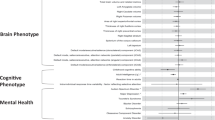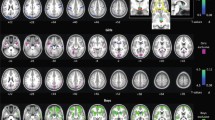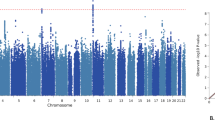Abstract
Genetic influences on behavior are complex and, as such, the effect of any single gene is likely to be modest. Neuroimaging measures may serve as a biological intermediate phenotype to investigate the effect of genes on human behavior. In particular, it is possible to constrain investigations by prior knowledge of gene characteristics and by including samples of subjects where the distribution of phenotypic variance is both wide and under heritable influences. Here, we use this approach to show a dissociation between the effects of two dopamine genes that are differentially expressed in the brain. We show that the DAT1 gene, a gene expressed predominantly in the basal ganglia, preferentially influences caudate volume, whereas the DRD4 gene, a gene expressed predominantly in the prefrontal cortex, preferentially influences prefrontal gray matter volume in a sample of subjects including subjects with ADHD, their unaffected siblings, and healthy controls. This demonstrates that, by constraining our investigations by prior knowledge of gene expression, including samples in which the distribution of phenotypic variance is wide and under heritable influences, and by using intermediate phenotypes, such as neuroimaging, we may begin to map out the pathways by which genes influence behavior.
This is a preview of subscription content, access via your institution
Access options
Subscribe to this journal
Receive 12 print issues and online access
$259.00 per year
only $21.58 per issue
Buy this article
- Purchase on Springer Link
- Instant access to full article PDF
Prices may be subject to local taxes which are calculated during checkout




Similar content being viewed by others
References
Fossella J, Sommer T, Fan J, Wu Y, Swanson JM, Pfaff DW et al. Assessing the molecular genetics of attention networks. BMC Neurosci 2002; 3: 14.
Paterson AD, Sunohara GA, Kennedy JL . Dopamine D4 receptor gene: novelty or nonsense? Neuropsychopharmacology 1999; 21: 3–16.
Lusher JM, Chandler C, Ball D . Dopamine D4 receptor gene (DRD4) is associated with Novelty Seeking (NS) and substance abuse: the saga continues. Mol Psychiatry 2001; 6: 497–499.
Kluger AN, Siegfried Z, Ebstein RP . A meta-analysis of the association between DRD4 polymorphism and novelty seeking. Mol Psychiatry 2002; 7: 712–717.
Krubitzer L, Kahn DM . Nature vs nurture revisited: an old idea with a new twist. Prog Neurobiol 2003; 70: 33–52.
Johnston MV, Jeon OH, Pevsner J, Blue ME, Naidu S . Neurobiology of Rett syndrome: a genetic disorder of synapse development. Brain Dev 2001; 23(Suppl 1): S206–S213.
Diamond A, Briand L, Fossella J, Gehlbach L . Genetic and neurochemical modulation of prefrontal cognitive functions in children. Am J Psychiatry 2004; 161: 125–132.
Castellanos FX, Tannock R . Neuroscience of attention-deficit/hyperactivity disorder: the search for endophenotypes. Nat Rev Neurosci 2002; 3: 617–628.
Hariri AR, Weinberger DR . Imaging genomics. Br Med Bull 2003; 65: 259–270.
Fan J, Fossella J, Sommer T, Wu Y, Posner MI . Mapping the genetic variation of executive attention onto brain activity. Proc Natl Acad Sci USA 2003; 100: 7406–7411.
Braver TS, Barch DM . A theory of cognitive control, aging cognition, and neuromodulation. Neurosci Biobehav Rev 2002; 26: 809–817.
Jones MW . A comparative review of rodent prefrontal cortex and working memory. Curr Mol Med 2002; 2: 639–647.
Botvinick MM, Braver TS, Barch DM, Carter CS, Cohen JD . Conflict monitoring and cognitive control. Psychol Rev 2001; 108: 624–652.
Casey BJ, Durston S, Fossella JA . Evidence for a mechanistic model of cognitive control. Clin Neurosci Res 2001; 1: 267–282.
Roderick TH, Wimer RE, Wimer CC, Schwartzkroin PA . Genetic and phenotypic variation in weight of brain and spinal cord between inbred strains of mice. Brain Res 1973; 64: 345–353.
Leamy L . Morphometric studies in inbred and hybrid house mice. VI. A genetical analysis of brain and body size. Behav Genet 1985; 15: 251–263.
Cheverud JM, Falk D, Hildebolt C, Moore AJ, Helmkamp RC, Vannier M . Heritability and association of cortical petalias in rhesus macaques (Macaca mulatta). Brain Behav Evol 990; 35: 368–372.
Finlay BL, Darlington RB . Linked regularities in the development and evolution of mammalian brains. Science 1995; 268: 1578–1584.
Bartley AJ, Jones DW, Weinberger DR . Genetic variability of human brain size and cortical gyral patterns. Brain 1997; 120: 257–269.
Baaré WFC, Hulshoff Pol HE, Boomsma DI, Posthuma D, de Geus EJ, Schnack HG et al. Quantitative genetic modeling of variation in human brain morphology. Cereb Cortex 2001; 11: 816–824.
Selemon LD, Lidow MS, Goldman-Rakic PS . Increased volume and glial density in primate prefrontal cortex associated with chronic antipsychotic drug exposure. Biol Psychiatry 1999; 46: 161–172.
Chakos MH, Lieberman JA, Bilder RM, Borenstein M, Lerner G, Bogerts B et al. Increase in caudate nuclei volumes of first-episode schizophrenic patients taking antipsychotic drugs. Am J Psychiatry 1994; 151: 1430–1436.
Chakos MH, Lieberman JA, Alvir J, Bilder R, Ashtari M . Caudate nuclei volumes in schizophrenic patients treated with typical antipsychotics or clozapine. Lancet 1995; 345: 456–457.
Hokama H, Shenton ME, Nestor PG, Kikinis R, Levitt JJ, Metcalf D et al. Caudate, putamen, and globus pallidus volume in schizophrenia: a quantitative MRI study. Psychiatry Res Neuroimaging 1995; 61: 209–229.
Scheepers FE, Gispen de Wied CC, Hulshoff Pol HE, van der Flier W, van der Linden JA, Kahn RS . The effect of clozapine on caudate nucleus volume in schizophrenic patients previously treated with typical antipsychotics. Neuropsychopharmacology 2001; 24: 47–54.
Heinz A, Goldman D, Jones DW, Palmour R, Hommer D, Gorey JG et al. Genotype influences in vivo dopamine transporter availability in human striatum. Neuropsychopharmacology 2000; 22: 133–139.
Jacobsen LK, Staley JK, Zoghbi SS, Seibyl JP, Kosten TR, Innis RB et al. Prediction of dopamine transporter binding availability by genotype: a preliminary report. Am J Psychiatry 2000; 157: 1700–1703.
Vandenbergh DJ, Thompson MD, Cook EH, Bendahhou E, Nguyen T, Krasowski MD et al. Human dopamine transporter gene: coding region conservation among normal, Tourette's disorder, alcohol dependence and attention-deficit hyperactivity disorder populations. Mol Psychiatry 2000; 5: 283–292.
Winsberg BG, Comings DE . Association of the dopamine transporter gene (DAT1) with poor methylphenidate response. J Am Acad Child Adolesc Psychiatry 1999; 38: 1474–1477.
Roman T, Schmitz M, Polanczyk G, Eizirik M, Rohde LA, Hutz MH . Attention-deficit hyperactivity disorder: a study of association with both the dopamine transporter gene and the dopamine D4 receptor gene. Am J Med Genet 2001; 105: 471–478.
Volkow ND, Wang GJ, Fowler JS, Gatley SJ, Logan J, Ding YS et al. Dopamine transporter occupancies in the human brain induced by therapeutic doses of oral methylphenidate. Am J Psychiatry 1998; 155: 1325–1331.
Volkow ND, Fowler JS, Wang G, Ding Y, Gatley SJ . Mechanism of action of methylphenidate: insights from PET imaging studies. J Atten Disord 2001; 6(Suppl 1): S31–S43.
Castellanos FX, Lau E, Tayebi N, Lee P, Long RE, Giedd JN et al. Lack of an association between a dopamine-4 receptor polymorphism and attention-deficit/hyperactivity disorder: genetic and brain morphometric analyses. Mol Psychiatry 1998; 3: 431–434.
Castellanos FX, Sharp WS, Gottesman RF, Greenstein DK, Giedd JN, Rapoport JL . Anatomic brain abnormalities in monozygotic twins discordant for attention deficit hyperactivity disorder. Am J Psychiatry 2003; 160: 1693–1696.
Durston S, Hulshoff Pol HE, Schnack HG, Buitelaar JK, Steenhuis MP, Minderaa RB et al. Magnetic resonance imaging of boys with attention deficit hyperactivity disorder and their unaffected siblings. J Am Acad Child Adolesc Psychiatry 2004; 43: 332–340.
Slaats-Willemse D, Swaab-Barneveld H, de Sonneville L, van der Meulen E, Buitelaar J . Deficient response inhibition as a cognitive endophenotype of ADHD. J Am Acad Child Adolesc Psychiatry 2003; 42: 1242–1248.
Cook E . Molecular genetic studies of attention deficit hyperactivity disorder. Wenner-Gren Foundations International Symposium: Neurobiology of ADHD. Stockholm, 2000.
Faraone SV, Doyle AE, Mick E, Biederman J . Meta-analysis of the association between the 7-repeat allele of the dopamine D(4) receptor gene and attention deficit hyperactivity disorder. Am J Psychiatry 2001; 58: 1052–1057.
Maher BS, Marazita ML, Ferrell RE, Vanyukov MM . Dopamine system genes and attention deficit hyperactivity disorder: a meta-analysis. Psychiatr Genet 2002; 2: 207–215.
Cook Jr EH, Stein MA, Krasowski MD, Cox NJ, Olkon DM, Kieffer JE et al. Association of attention-deficit disorder and the dopamine transporter gene. Am J Hum Genet 1995; 56: 993–998.
LaHoste GJ, Swanson JM, Wigal SB, Glabe C, Wigal T, King N et al. Dopamine D4 receptor gene polymorphism is associated with attention deficit hyperactivity disorder. Mol Psychiatry 1996; 1: 121–124.
Ding YC, Chi HC, Grady DL, Morishima A, Kidd JR, Kidd KK et al. Evidence of positive selection acting at the human dopamine receptor D4 gene locus. Proc Natl Acad Sci USA 2002; 99: 309–314.
Wang E, Ding YC, Flodman P, Kidd JR, Kidd KK, Grady DL et al. The genetic architecture of selection at the human dopamine receptor D4 (DRD4) gene locus. Am J Hum Genet 2004; 74: 931–944.
Swanson J, Oosterlaan J, Murias M, Schuck S, Flodman P, Spence MA et al. Attention deficit/hyperactivity disorder children with a 7-repeat allele of the dopamine receptor D4 gene have extreme behavior but normal performance on critical neuropsychological tests of attention. Proc Natl Acad Sci USA 2000; 97: 4754–4759.
Manor I, Tyano S, Eisenberg J, Bachner-Melman R, Kotler M, Ebstein RP . The short DRD4 repeats confer risk to attention deficit hyperactivity disorder in a family-based design and impair performance on a continuous performance test (TOVA). Mol Psychiatry 2002; 7: 790–794.
Langley K, Marshall L, van den Bree M, Thomas H, Owen M, O’Donovan M et al. Association of the dopamine D4 receptor gene 7-repeat allele with neuropsychological test performance of children with ADHD. Am J Psychiatry 2004; 161: 133–138.
Leung PWL, Lee CC, Hung SF, Ho TP, Tang CP, Kwong SL et al. The dopamine receptor D4 (DRD4 gene in Han Chinese children with attention-deficit/hyperactivity disorder (ADHD): increased prevalence of the 2-repeat allele. Am J Med Genet B Neuropsychiatr Genet 2005; 133B: 54–56.
De La Garza Jr R, Madras BK . [(3)H]PNU-101958, a D(4) dopamine receptor probe, accumulates in prefrontal cortex and hippocampus of non-human primate brain. Synapse 2000; 37: 232–244.
Lahti RA, Roberts RC, Tamminga CA . D2-family receptor distribution in human postmortem tissue, an autoradiographic study. Neuroreport 1995; 6: 2505–2512.
Primus RJ, Thurkauf A, Xu J, Yevich E, McInerney S, Shaw K et al. Localization and characterization of dopamine D4 binding sites in rat and human brain by use of the novel, D4 receptor-selective ligand [3H]NGD 94-1. J Pharmacol Exp Ther 1997; 282: 1020–1027.
Stefanis NC, Bresnick JN, Kerwin RW, Schofield WN, McAllister G . Elevation of D4 dopamine receptor mRNA in postmortem schizophrenic brain. Brain Res Mol Brain Res 1998; 53: 112–119.
Durston S . A review of the biological bases of ADHD: What have we learned from imaging studies? Ment Retard Dev Disabil Res Rev 2003; 9: 184–195.
Shaffer D, Fisher P, Lucas C, Dulcan M, Schwab-Stone M . NIMH Diagnostic Interview Schedule for Children version IV (NIMH DISC-IV): description, differences from previous versions, and reliability of some common diagnoses. J Am Acad Child Adolesc Psychiatry 2000; 39: 28–38.
Achenbach TM, Edelbrock CS . Manual for the Child Behavior Checklist and Revised Profile. University of Vermont, Department of Psychiatry: Burlington, VT, 1983.
Achenbach T M . Integrative Guide for the 1991 CBCL/4-18, YSR, and TRF Profiles. University of Vermont, Department of Psychiatry: Burlington, VT, 1991.
Wechsler D . Wechsler Intelligence Scale for Children—Revised (WISC-R). Psychological Corporation: New York, 1974.
Schnack HG, Hulshoff Pol HE, Baaré WFC, Staal WG, Viergever MA, Kahn RS . Automated separation of gray and white matter from MR images of the human brain. Neuroimage 2001; 13: 230–237.
Schnack HG, Hulshoff Pol HE, Baaré WFC, Viergever MA, Kahn RS . Automatic segmentation of the ventricular system from MR images of the human brain. Neuroimage 2001; 14: 95–104.
Casey BJ, Castellanos FX, Giedd JN, Marsh WL, Hamburger SD, Schubert AB et al. Implication of right frontostriatal circuitry in response inhibition and attention-deficit/hyperactivity disorder. J Am Acad Child Adolesc Psychiatry 1997; 36: 374–383.
Grady DL, Chi HC, Ding YC, Smith M, Wang E, Schuck S et al. High prevalence of rare dopamine receptor D4 alleles in children diagnosed with attention-deficit hyperactivity disorder. Mol Psychiatry 2003; 8: 536–545.
Acknowledgements
We gratefully acknowledge all the families that participated in this study, Jacqueline Jansen and Chantal Kemner for their role in subject recruitment, René Mandl for technical assistance, Richard Sinke, Ruben van‘t Slot and Steven Bakker for their help in preparation and shipment of the DNA samples, and Jim Swanson for helpful discussions. This work was supported in part by grants from the Netherlands Organisation for Scientific Research (NWO) and the Dutch brain foundation (Hersenstichting Nederland) to SD.
Author information
Authors and Affiliations
Corresponding author
Rights and permissions
About this article
Cite this article
Durston, S., Fossella, J., Casey, B. et al. Differential effects of DRD4 and DAT1 genotype on fronto-striatal gray matter volumes in a sample of subjects with attention deficit hyperactivity disorder, their unaffected siblings, and controls. Mol Psychiatry 10, 678–685 (2005). https://doi.org/10.1038/sj.mp.4001649
Received:
Revised:
Accepted:
Published:
Issue Date:
DOI: https://doi.org/10.1038/sj.mp.4001649
Keywords
This article is cited by
-
Genetic variations influence brain changes in patients with attention-deficit hyperactivity disorder
Translational Psychiatry (2021)
-
Dopamine D4 Receptor Gene Associated with the Frontal-Striatal-Cerebellar Loop in Children with ADHD: A Resting-State fMRI Study
Neuroscience Bulletin (2018)
-
Imaging genetics in attention-deficit/hyperactivity disorder and related neurodevelopmental domains: state of the art
Brain Imaging and Behavior (2017)
-
Enlarged striatal volume in adults with ADHD carrying the 9-6 haplotype of the dopamine transporter gene DAT1
Journal of Neural Transmission (2016)
-
Altered Corticostriatal Connectivity and Exploration/Exploitation Imbalance Emerge as Intermediate Phenotypes for a Neonatal Dopamine Dysfunction
Neuropsychopharmacology (2015)



